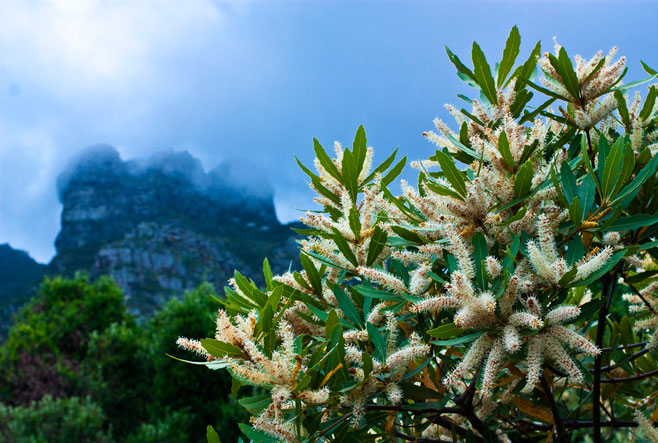Brabejum stellatifolium
(Wild Almond, Bitter almond) [= Brabeium stellatifolium) Wilde-amandel, Bitteramandel, Ghoeboontjie [Afrikaans] Life
> eukaryotes >
Archaeoplastida >
Chloroplastida
>
Charophyta > Streptophytina > Plantae (land plants)
> Tracheophyta (vascular plants) > Euphyllophyta > Lignophyta (woody plants)
> Spermatophyta (seed plants) > Angiospermae (flowering
plants) > Eudicotyledons > Order: Proteales
> Family: Proteaceae
 |
|
The Wild almond (Brabejum stellatifolium)
flowering in early summer at Kirstenbosch with Castle Rock under cloud
beyond, Cape Peninsula, Western Cape, South Africa. [photo
Colin Paterson-Jones ©] |
 |
|
The Wild almond (Brabejum stellatifolium),
Kirstenbosch Botanical Gardens, Cape Peninsula, South Africa. [photo
H.G.
Robertson, Iziko ©] |
 |
 |
|
The Wild almond (Brabejum stellatifolium)
flowering in summer next to a stream in the Elandsberg mountains,
Western Cape, South Africa. [photo
Colin Paterson-Jones ©] |
A Wild almond (Brabejum stellatifolium)
tree, part of Van Riebeeck's Hedge, flowering in early summer in the
Kirstenbosch Botanic Garden, Cape Peninsula, Western Cape, South Africa. [photo
Colin Paterson-Jones ©] |
Grows into a large bush or small tree. Jan van Riebeeck, who started the
Dutch settlement at the Cape, planted a hedge of Wild almond in 1960 to keep out
the local indigenous people. Plants originating from this hedge can still be
seen at Kirstenbosch National Botanical Gardens.
Identification
- A large bush or tree, growing to about 8 m in height.
- The leaves are in whorls of 6, giving them a star-like
appearance when viewed from above, hence the latin name
stellatifolium ("leaves radiating like the points of a
star"). Leaves are simple, elongate, with unevenly toothed
margins.
- The bark is smooth and greyish in colour.
- The small, sweet-scented flowers are in spikes up to 8 cm
long.
- The fruit have a golden furry exterior and in general
appearance look like the fruit of the
Almond, hence the
common name, even though Wild almond is in the protea family (Proteaceae)
whereas the real Almond is in the
Rosaceae (the leaves of the
two plants also look vaguely similar with their toothed
margins). Brabejum fruit evidently float and as plants
often grow along streams, the fruit are dispersed by water.
Brabejum stellatifolium is the only
member of Brabejum and falls in the subfamily of the protea
family called the Grevilleoideae whereas all other indigenous
members of the Proteaceae in southern Africa fall in the subfamily
Proteoideae. The Grevilleoideae is well represented in Australia and
Brabejum is most closely related to
Macadamia.
Distribution and habitat
Limited to the southwestern region of the
Western Cape, South Africa, growing in sheltered valleys and along
streams.
Phenology
- Flowers from December to January.
- Fruits from February to May.
Ecological interactions
- Flowers are pollinated by:
- Fruit are eaten by:
- The leaves often have wart-like galls in them caused by
mites.
Uses
- Jan van Riebeeck, the first governer of the newly started
Dutch settlement at the Cape, planted a hedge of Wild Almond
along the border of the colony as it was then, in about 1660, in
an attempt to prevent theft of livestock by the local indigenous
Koikoi. Part of this hedge can be seen in the Kirstenbosch
Botanical Gardens
- The Koikoi ate the roots as food in winter.
- The seeds in the fruit are poisonous as they contain
cyanogenic glycosides but after treatment they can be eaten. The
poison is leached out by placing the seeds in sacks and running
them under water for 'a long time'. Alternatively, they are
soaked in water for a few days, boiled and then roasted.
- In the past the roasted seeds were ground up and used as a
coffee substitute.
- The wood is reddish-coloured and has been used for making
ornaments.
Links
References
- Palgrave, K.C. and Palgrave, M.C. 2002. Trees of Southern Africa. 3rd
Edition. Struik Publishers, Cape Town.
- Palmer, E. and Pitman, N. 1972. Trees of Southern Africa covering all
known indigenous species in the Republic of South Africa, South-West Africa,
Botswana, Lesotho and Swaziland. Volume 1. A.A. Balkema, Cape
Town.
Text by Hamish Robertson |
